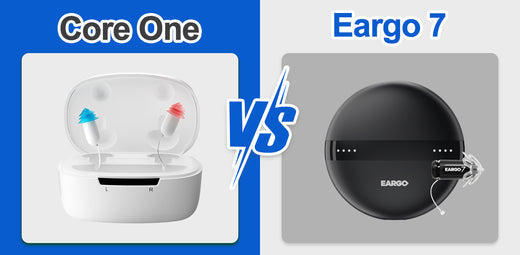
Eargo 7 Hearing Aids: Reviews, Price & Alternatives

The NIH says over 28.8 million U.S. adults may be helped by hearing aids, so it’s never been more relevant to find effective and affordable hearing aids. As newer over-the-counter (OTC) options emerge following the FDA's 2022 ruling, two notable contenders are the Eargo 7 and its competitor, the Ceretone Core One.
While Eargo 7 reviews highlight its nearly invisible design and smartphone integration, consumers increasingly seek Eargo alternatives that offer similar benefits at different price points. This comparison guide examines how these two OTC hearing aids—Eargo 7 and Ceretone Core One—stack up in terms of features, user experience, and value.
Therefore, let it be that you make a decision based on information on which device might be best suited to meet your needs and the budget. If you are new to hearing assistive technology or upgrading existing devices, this analysis offers the essential information you need.
So, let’s delve deep into the comparison of Ceretone Core One vs Eargo 7 hearing aids in this comprehensive review guide.
Ceretone Core One vs Eargo 7: Product Specifications
Here is a table for a quick and easy understanding of the key product specifications of Eargo 7 and Ceretone Core One.
|
Product |
Eargo 7 |
Ceretone Core One |
|
Image |
|
|
|
Check Details |
||
|
Price |
$2390 |
$349 |
|
App Control |
Eargo APP |
|
|
Auto Turn On/Off |
✔ |
✔ |
|
Delayed Turn On |
✔ |
✔ |
|
Charging Time |
4 Hours |
2 Hours |
|
Battery Life |
Rechargeable; 16 hours/charge |
Rechargeable; 13 hours/charge |
|
Customization |
Multiple Eargo 7 mic caps for different sound profiles |
App-based sound adjustment |
|
Smartphone App |
Yes, for Sound Match technology |
Yes, for adjustments and controls |
|
Noise Reduction |
Advanced background noise reduction |
Pro-Level noise reduction |
|
Design |
Completely-in-canal (CIC) |
Invisible-in-Canal (IIC) Hearing Aids |
|
Sound Processing |
Sound Match 2.0 technology; Auto environmental adaptation |
Digital noise reduction |
|
Water Resistance |
IPX7 rated |
IP66 rated |
|
Return |
45-day return policy |
60-Day Risk-Free Trial |
|
Dome |
Closed and Open Petals |
3 Sizes of Eartips Available |
The Eargo - 7 showcases excellence with its practically invisible design complemented by sophisticated sound personalization. It has innovative Sound Match technology and boosted sound processing algorithms that make it sound clearer.
A standout feature is the Eargo 7 mic caps, which incorporate Sound Adjust+ technology to automatically optimize sound settings based on your environment. The Eargo 7 battery life impresses with up to 16 hours of use per charge, supported by a portable charging case that provides multiple extra charges for extended use.
The Ceretone Core One otc hearing aids, on the other hand, has its own invisible-in-canal design and matches this discretion, but with some distinct advantages. This has advanced noise cancellation technology and various sound environment settings that change automatically depending on the listening situation. The Core One's rechargeable battery system offers strong battery life (13 hours on a single charge), and the smartphone Ceretone app offers fine-tuning of the hearing experience with precise controls.
The latest in miniaturization technology, both devices fit in the ear canal and provide powerful hearing enhancement. While the Eargo 7 emphasizes its proprietary Sound Match system and environmental adaptability, the Core One counters with competitive features at a more accessible price point.
As hearing solutions, these devices are excellent for users looking for discreet hearing aids and high-performance hearing, and the final choice generally comes down to personal preferences, specific features, and price.
Ceretone Core One vs Eargo 7: Reviews
The over-the-counter (OTC) hearing aid market has seen significant growth, with the Eargo 7 self-fitting OTC CIC hearing aid emerging as a premium option. However, the Ceretone Core One presents itself as a compelling alternative, especially considering the substantial Eargo 7 cost.
While the Eargo 7 hearing aids come with advanced features and the innovative Eargo 7 app, the Core One offers similar functionality at a fraction of the cost.
Ceretone Core One: Pros and Cons

|
Pros |
Cons |
|
Highly affordable ($349) |
Basic app functionality |
|
78 hours use with charging case |
Limited sound customization options |
|
Smallest design in the world |
Dual mic system (vs quad) |
|
Weight < 0.04 oz |
Less advanced noise reduction |
|
Cleaning Tools for Easy maintenance |
Fewer premium features |
|
Comfortable fit |
|
|
IP66 Waterproof |
Eargo 7: Pros and Cons

|
Pros |
Cons |
|
Advanced Sound Match technology |
Premium price point ($2390) |
|
Superior noise reduction |
No Bluetooth connectivity |
|
Quad microphone system |
Higher maintenance with mic caps |
|
Comprehensive mobile app |
Battery life could be better |
|
IPX7 water resistance |
Steep learning curve for app features |
|
Virtually invisible design |
Premium support may require subscription |
|
Sound personalization |
Some users report fit issues |
Analysis of Pros and Cons
The Eargo 7 stands out with its sophisticated features like advanced noise reduction, quad microphones, and the comprehensive Eargo 7 app experience. Many Eargo 7 reviews highlight its excellent sound quality and discreet design. However, it doesn’t have a Bluetooth connectivity feature.
The Ceretone Core One, while offering 90% of the Eargo 7 experience, comes at just 15% of the cost. It matches most essential features, such as noise reduction and app control. The Core One certainly offers great value for money for users wanting sound quality in their hearing aids without the premium price tag. You can check Ceretone hearing aid reviews, and you will find that Ceretone is trustworthy and worth investing in.
For budget-conscious consumers who prioritize core functionality over premium features, the Ceretone Core One presents a compelling alternative to the Eargo 7, offering similar essential features while being significantly more affordable.
Ceretone Core One vs Eargo 7: How to Choose
When selecting between these innovative OTC hearing aids, several key factors deserve careful consideration:
- Design & Discretion: A nice touch for both devices is that they are invisible in canal (IIC) hearing aids. However, the Ceretone Core One breaks new ground as being only 0.04 oz, making it extremely comfortable to wear for extended periods. It is the smallest hearing aid in the world. While the Eargo 7 petals design has its merits, Core One's small and ultra-light design often goes unnoticed by wearers.

- Smart Features & Control: The devices both have smartphone app control for iOS and Android. The Eargo 7's self-fitting technology is noteworthy, while Core One's app interface provides intuitive sound adjustments with premium noise reduction capabilities for clear conversations.
- Battery Life & Durability: The Core One offers up to 13 hours of use per charge, complemented by a portable charging case. The Core One IP66 waterproof hearing aids provide excellent protection against water and dust - a crucial factor for active lifestyles. The Eargo 7 provides a slightly longer battery life of 16 hours. But for daily life, Ceretone Core One’s 13 hours per charge is enough.
Key Decision Factors:
- Comfort priority
- App Control
- Battery Life
- Discreet design
- Water resistance needs
- Sound clarity preferences
- FDA registration compliance
- And most importantly, price point considerations
The Core One offers compelling advantages for users who want a truly weightless experience with premium sound quality and durability at an affordable, budget-friendly price in the modern hearing aid market.

Conclusion
Our thorough analysis comparing the Eargo 7 hearing aid to the Ceretone Core One shows that both are compelling options for various user needs.
While the Eargo 7 review consistently praises its advanced Sound Match technology and sophisticated noise reduction capabilities, its price point of $2,950 may give pause to budget-conscious consumers.
At $349, the Ceretone Core One stands out as a cost-effective choice, if not outright superior, with identical core features and even better battery life than the Eargo 7. The price differential between the Eargo 7 and the Core One is significant, while the Core One still maintains essential functionality.
The Eargo 7 shows the exciting evolution of OTC hearing aids, while the Core One does well in terms of value proposition and almost delivers 80-90% of all the features and specs you get from the Eargo 7.











